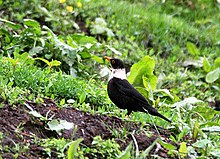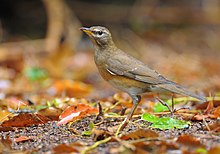Real thrushes
This article has been registered in the quality assurance biology for improvement due to formal or content-related deficiencies . This is done in order to bring the quality of the biology articles to an acceptable level. Please help improve this article! Articles that are not significantly improved can be deleted if necessary.
Read the more detailed information in the minimum requirements for biology articles .
| Real thrushes | ||||||||||||
|---|---|---|---|---|---|---|---|---|---|---|---|---|

American thrush ( Turdus migratorius ) |
||||||||||||
| Systematics | ||||||||||||
|
||||||||||||
| Scientific name | ||||||||||||
| Turdus | ||||||||||||
| Linnaeus , 1758 |
The real thrushes ( Turdus ) are a genus of the thrush family (Turdidae). They are characterized by relatively long legs and large eyes. They feed on berries and invertebrates such as insects and worms, and like to hop on the ground for prey. Many species are migratory birds .
The thrushes in the narrower sense are the largest genus within the thrushes with 80 species and numerous subspecies . They occur in both temperate and tropical regions of the world. In all species, the breast plumage often has triangle-like dark spots, a thrush markings . Hence the name thrush .
Known species
The thrush includes the 25 centimeter large blackbird or black thrush ( Turdus merula ) , which is widespread in Europe . After the first spring moult, the males of the blackbird are continuously black with a yellow bill, the females have brown plumage.
As a cultural follower , this originally pure forest bird also lives in cities. The nests are u. a. laid out on trees and in bushes. The clutch comprises four to five green to reddish spotted eggs.
Is slightly smaller that occurring in Europe and Asia Song Thrush ( Turdus philomelos ). Their upper side is colored brown, the light underside with black spots. As a migratory bird, it resides in the Central European breeding areas from the beginning of March.
The slightly larger, grayish mistletoe thrush ( Turdus viscivorus ) feeds on snails , insects , worms and in autumn on berries , similar to the song thrush . By eating mistletoe , she helps spread these plants.
The fieldfare ( Turdus pilaris ) is relatively conspicuous with its gray head and rump as well as the red-brown dorsal plumage. It has been expanding its breeding area towards the west since the last Ice Age , and its population is increasing in Germany. It used to be caught and eaten as the Krammetsvogel (the name for the field thrush at the time). The species mentioned have a melodic song.
On the train and as a winter guest from the north, the red thrush ( Turdus iliacus ) appears in Central Europe , which, in contrast to the song thrush, has rust-red underwing coverts. Especially on October and November nights in Central Europe you can hear the call of wandering red thrushes that sound like "pulling".
In North America the American thrush ( Turdus migratorius ) occupies the ecological niche that the blackbird has in Central Europe .
species








- Gmelind thrush ( Turdus abyssinicus )
- Black Thrush ( Turdus albicollis )
- White-necked Thrush ( Turdus albocinctus )
- Cream-bellied thrush ( Turdus amaurochalinus )
- Sepia Thrush ( Turdus assimilis )
- Black throat thrush ( Turdus atrogularis )
- White Chinstrap ( Turdus aurantius )
- Comorian thrush ( Turdus bewsheri )
- Bulbulamsel or gray-winged thrush ( Turdus boulboul )
- Check throttle ( Turdus cardis )
- Kurodadrossel ( Turdus celaenops )
- Chiguancodrossel ( Turdus chiguanco )
- Red-headed thrush ( Turdus chrysolaus )
- Dagua thrush ( Turdus daguae )
- Black-breasted thrush ( Turdus dissimilis )
- Nauman's thrush ( Turdus eunomus )
- Magellan Thrush ( Turdus falcklandii )
- Rust thrush ( Turdus feae )
- Coal thrush ( Turdus flavipes )
- Ocher-bellied thrush ( Turdus fulviventris )
- Cocoa thrush ( Turdus fumigatus )
- Giant thrush ( Turdus fuscater )
- Yellow Thrush ( Turdus grayi )
- Palmarito thrush ( Turdus haplochrous )
- Pale-bellied thrush ( Turdus hauxwelli )
- Taita thrush ( Turdus helleri )
- Garden throttle ( Turdus Hortulorum )
- Black- billed Thrush ( Turdus ignobilis )
- Redwing ( Turdus iliacus )
- Guatemala thrush ( Turdus infuscatus )
- White-eyed thrush ( Turdus jamaicensis )
- Rhododendron thrush ( Turdus kessleri )
- Lawrence's thrush ( Turdus lawrencii )
- Pale-breasted thrush ( Turdus leucomelas )
- Taczanowski's thrush ( Turdus leucops )
- Antilles thrush ( Turdus lherminieri )
- Red-billed thrush ( Turdus libonyanus )
- Somali thrush ( Turdus ludoviciae )
- Berlepsch's thrush ( Turdus maculirostris )
- Maranondrossel ( Turdus maranonicus )
- Veil thrush ( Turdus menachensis )
- Blackbird ( Turdus merula )
- American thrush ( Turdus migratorius )
- Chinasing thrush ( Turdus mupinensis )
- Tibetan Blackbird ( Turdus maximus )
- Nauman's thrush ( Turdus naumanni )
- Soot Thrush ( Turdus nigrescens )
- White-axed thrush ( Turdus nigriceps )
- Naked eyes throttle ( Turdus nudigenis )
- White-browed thrush ( Turdus obscurus )
- White-tailed Thrush ( Turdus obsoletus )
- Sao Tome Thrush ( Turdus olivaceofuscus )
- Cape Thrush ( Turdus olivaceus )
- Hooded Thrush ( Turdus olivater )
- Pale Thrush ( Turdus pallidus )
- African thrush ( Turdus pelios )
- Song thrush ( Turdus philomelos )
- Fieldfare ( Turdus pilaris )
- Cabani thrush ( Turdus plebejus )
- Red-footed thrush ( Turdus plumbeus )
-
South Sea Thrush ( Turdus poliocephalus ) - 51 subspecies
- Lord Howe Island Thrush (
- Norfolk Island Thrush ( Turdus poliocephalus poliocephalus )
